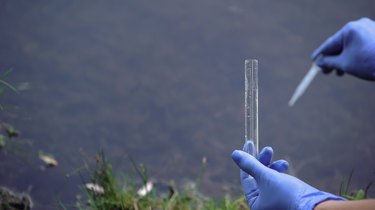One of the more challenging aspects of fishkeeping is maintaining proper water conditions. Testing the pH of your water will tell you if the water is too acidic or too alkaline for your fish. Low alkalinity in a fish tank inhibits beneficial bacteria that help process fish waste, so knowing how to raise it is vital to the health of your aquarium.

Video of the Day
What is pH?
The term "pH" is a shortened version of "puissance (powers) of hydrogen." Since the capital letter "H" is the symbol for hydrogen in the atomic table, the letter is always capitalized. The concept of pH of any aqueous solution originated in 1909 by Danish scientist Soren Sorenson, who worked in the laboratory at Carlsberg Breweries.
Video of the Day
The scale assigns a value of 1 to 14 to an aqueous solution. Pure water is neutral, so it lies at 7 on the pH scale since it is composed of equal parts hydrogen and oxygen. Anything lower than 7 is considered to be on the acidic side of the pH scale, and higher than 7 is alkaline.
The pH in your tank will fluctuate based on the minerals and chemicals dissolved in it. During a typical day, the pH in a planted tank can drop at night as plants increase transpiration, putting off more oxygen. The type of decorations and substrate you have also affect the pH as well as the biological processes of the fish themselves.
The right pH for fish
Just like your tank environment affects the pH of the water, so does a fish's natural habitat. That means that the ideal alkalinity for a freshwater aquarium reflects the water where your species of fish originates. In general, freshwater fish can usually adapt to and feel healthiest in conditions ranging from 5.5 to 7.5. Saltwater fish require total alkalinity in the aquarium to be 8.0 to 8.1. Consult a fish pH chart to determine what is right for your tank.
That doesn't mean any freshwater fish will thrive if their ideal pH is 7.5 and your tank is 5.5. It's important to keep tank conditions at levels suited for the species you are keeping and plan your substrate and decor to support those parameters.
Clues that your tank might be getting too acidic for your fish include limited growth, the appearance of stress, and gasping. Your fish might also develop physical signs in a chronically acidic environment, such as eye problems and thickened skin and gills.
Rectifying low alkalinity in a fish tank
Increasing your tank's alkalinity is simple, but you need to be sure that you don't overdo it. Rapid changes in pH can stress your fish to the point of death, especially if they're young or ill. Remove your fish to a hospital tank. Vacuum the gravel, do a partial water change, and wipe the sides, plants, and decorations. Then, check the pH again.
Prepare a solution using conditioned water and dissolve 1 teaspoon of baking soda for every 5 gallons of water in the tank you are treating. Once dissolved, add the solution to the tank and allow it to cycle before reintroducing your fish.
If your tank tends to go acidic, consider changing the substrate to dolomite gravel or crushed coral. Tank decorations, such a pieces of coral or limestone, contain calcium carbonate that can raise the alkalinity. Remove painted or deteriorating decor, costume jewels, ceramics, concrete, large rocks, and other items that could be leaching chemicals that could be making the tank acidic.
- Nature Physics: Powers of Hydrogen
- Fish Lab: What Is pH and How to Easily Test It in Your Aquarium?
- Algone: How to Adjust the pH in Your Aquarium
- PetHelpful: How to Decorate Your Fish Tank: Dos and Don'ts
- Chicago Tribune: How to Increase pH in an Aquarium
- National Oceanic and Atmospheric Administration: Ocean Acidification